|
|
Last Wednesday afternoon, at the conclusion of our semi-annual family reunion, which was held this year at the Double Arrow Resort in Seeley Lake, a group of 17 family members, including my husband, my son and myself, headed north to the Flathead and Glacier National Park. Following an obligatory lunch at Moose’s Pizza in Kalispell, a small subset of that group went into Glacier National Park for the evening. As we’d be heading up Going to the Sun the following day, I guided the group up the North Fork on that evening. I was surprised and a bit dismayed, upon our arrival on the road leading into Polebridge, to see that several of the signs that I have chuckled over (but heeded!) in years past are no longer present, such as these:

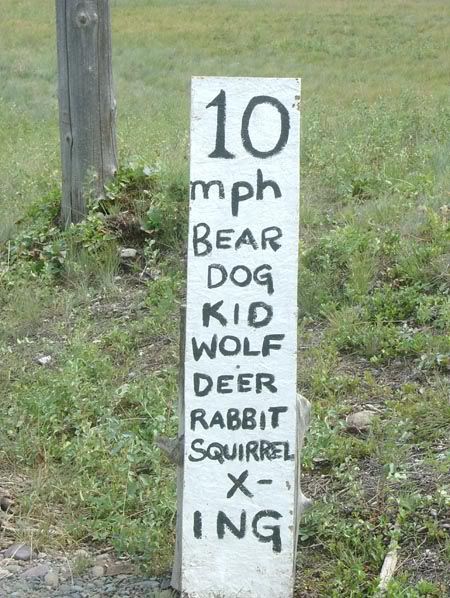
Thankfully, the most important sign remains.
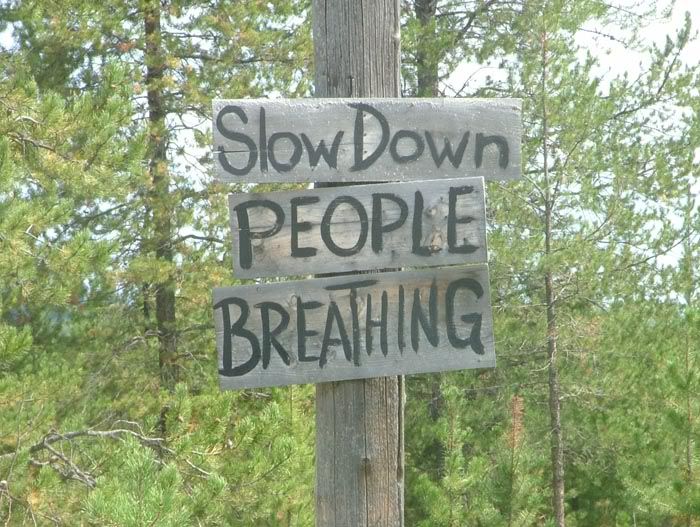
Another minor disappointment was the outhouse behind the Polebridge Mercantile. In years past it was a delightful outhouse. Truly. It was clean, it had a nice seat, its “aroma” was as pleasant as is possible for a primitive outhouse, and, if you forgot to take reading material in with you, you could pull a book from the nicely book-lined shelf. If you didn’t want to leave the book behind, you could drop some cash in a jar and take the book with you. If you were there in years gone by, you know of what I speak. It’s not that way anymore. Well, the books are there — in a box, no longer shelved, and the jar is there, but it’s not the same. The state of the outhouse has declined severely. Yes, such things can disappoint me. I was afraid that my relatives would find it downright appalling, so I suggested they use the facilities at the bar, instead. I still dropped a couple bucks in the jar for the use of the facility. It is, after all, an expense for the Merc.
The bakery at the Polebridge Mercantile, however, did not disappoint. It was as wonderfully stocked with cookies and rolls as always. The kids left stocked with cookies and I left stocked with savory rolls. The dinner hour was approaching and the picnic tables in front of the bar/restaurant were filling up. I’ve heard good things but have not yet dined there. That’s a lapse that will have to be remedied in the near future.
After our stop in Polebridge, we headed up to Big Prairie. Big Prairie is the epitome of Big Sky Country — a wide open high country park with the Livingston Mountain Range as backdrop.
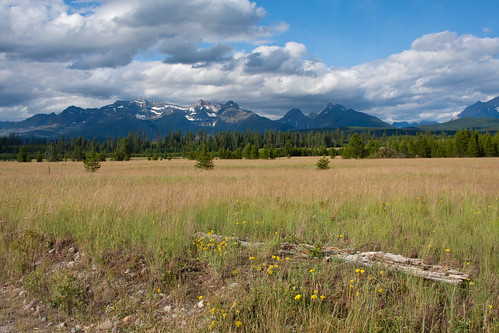
We stopped near the McCarthy Homestead.

Can you imagine having this scene for a front yard?
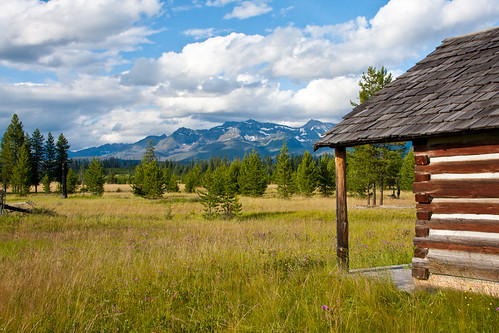
The McCarthy Homestead Cabin is a remnant of early settlement in what would become Glacier National Park. Jeremiah McCarthy built the log homestead in the North Fork area in 1908 after completion of the North Fork Road and passage of the Forest Homestead Act.
The cabin is the only representative of pre-1910 homesteading activity on the west side of the Continental Divide in Glacier. During the 1930s a Civilian Conservation Corps camp was built nearby. At about the same time, the cabin, and others nearby, transitioned from homesteading inholdings to summer cabins for their owners. In the 1950s some of the CCC structures were relocated to the vicinity of the cabin. The National Park Service purchased the property in 1970.
source: http://en.wikipedia.org/wiki/McCarthy_Homestead_Cabin
Time and the gas supply in one of the cars was running short, so we turned around after spending a bit of time in the vicinity of the McCarthy Homestead. We didn’t make it up to Kintla or Bowman Lakes. I’m thinking a trip to the lakes and dinner in Polebridge soon sounds like a great idea.
The following morning, 17 people in 5 cars headed into the Park. As several people were interested in a hike and the trails further up the pass are still under several feet of snow, I had suggested a stop at Avalanche where those who were only interested in a short walk could do the Trail of the Cedars while those who wanted a longer hike could continue up to Avalanche Lake. Along the way, some of the cars (including mine) made several stops along McDonald Creek. When I was there last month, a cold wet spring was still holding court. Summer has now arrived.
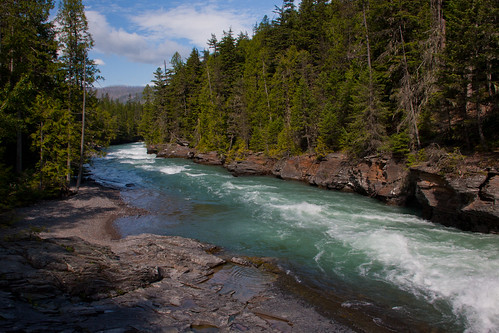
The trail up to Avalanche Lake starts at Avalanche Gorge and parallels the gorge for the first hundred yards or so.
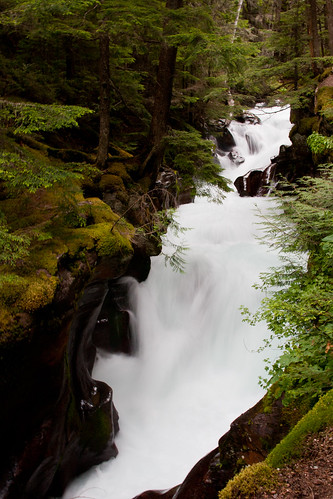
Once past the gorge, the trail passes through an old growth cedar and hemlock forest, littered with fallen trees (the shallow root system of those huge trees that is revealed when the trees are knocked over by wind always astounds me), moss covered boulders, ferns and other moist forest loving plants.
I enjoyed the “ah!” moment when the cousins with whom I was hiking got their first look of Avalanche Lake. Believe it or not, this was my first trip to Avalanche Lake as well. I was even a bit relieved that the “prize” at the end of the trail was a good one. It’s not that I was truly worried, having seen photos and whatnot, but…
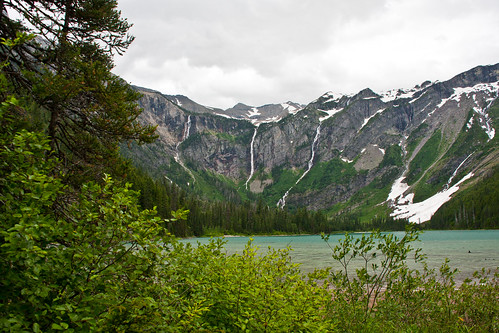
We enjoyed a picnic lunch at the lake and some time to just sit back and enjoy the view.
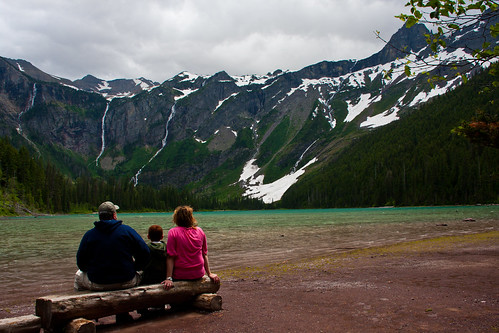
I would have wished for a nicer sky, but we can’t get everything we want, I guess. Nonetheless, I think we could have enjoyed staying even longer, but we knew we were lagging far behind the rest of the hikers and had best get moving.
When we arrived back at the parking lot we found a note from my husband informing us that the rest of the group, having tired of waiting for us (and I remain baffled as to why they did so at all) had gone up to Logan Pass. We drove up Going to the Sun Road to join them there at the Visitor Center. We had to stop for two short construction zones. Glacier is not a bad place to be forced to sit on the road waiting for your turn for the singe lane. There is always something to look at.
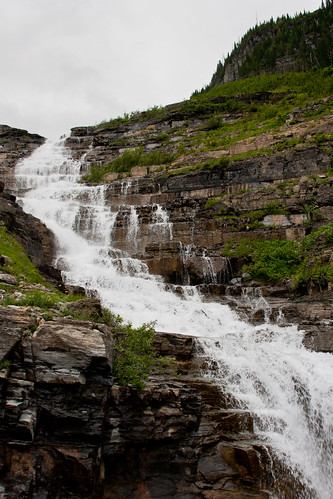
It was dark, sleeting and windy when we arrived at Logan Pass so I never even took my camera out of the car. We rearranged vehicle occupants and head south for Missoula, stopping at Ricciardis on Finley Point of Flathead Lake for dinner. They weren’t able to seat a party of 17, but could accommodate 4 tables of 4-5 people. Whoohoo! A nice dinner, with great company, and with the Singing Sons of Beaches serenading the diners was a great way to cap off the day.
More photos from the trip here: http://www.bigskycountry.net/glacier_july2011
I’ve been making trips up to Packer Meadows periodically for the last 4 weeks or so to check on the camas bloom. When last I visited a week and half ago, only a handful of camas had bloomed. When I arrived last night, I found that, as Captain Meriwether Lewis noted in his journal, “”the quawmash is now in blume.”
“the quawmash is now in blume
and from the colour of its bloom at
a short distance it resembles lakes
of fine clear water, so complete is
this deseption that on first sight I
could have swoarn it was water.”
So said Captain Meriwether Lewis on June 12, 1806. He also noted that “Musquetoes our old companions have become very troublesome.”
Note that the camas was in bloom on June 12 in 1806. This year it bloomed about 4 weeks behind that pace.

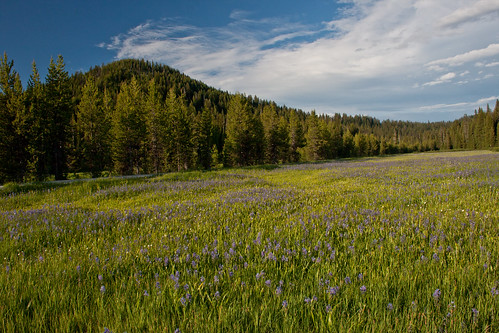
The mosquitoes remain very troublesome — that much hasn’t changed at all in 200 years. When I felt weak from blood loss there was enough daylight left that I decided to see if Elk Meadows Road was passable through. A week and a half ago it most definitely was not as you might recall if you read my “Suddenly Summer” blog post last week.
As I drove along, I seemed to be stopping about every 15 yards to enjoy the abundant beargrass, silvery lupine, rosy paintbrush, penstemon, American bistort, sitka valerian, bog orchid, and probably several other wildflowers that I am forgetting. There is truly a bumper crop of beargrass.
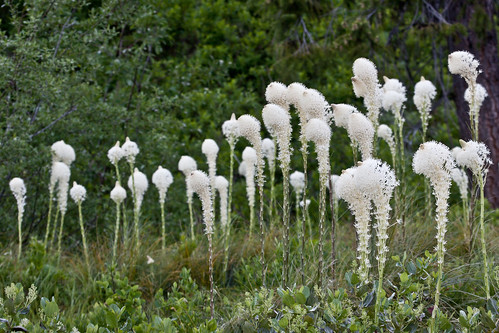

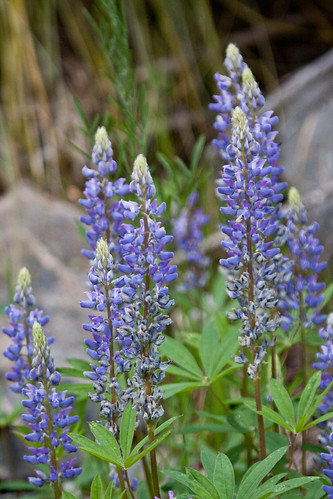
I became optimistic that the I’d be able to make it through to Lily Lake, having encountered no major snow (just little patches) up to this point. I continued to amble along, and continued to “stop and smell the roses.”
I made so many stops that the sun had already set when I was still a mile or two away from Lily Lake. The alpenglow on the peaks made me stop again.

Just past that point I encountered snow. I crossed my fingers that I’d be able to make it to Lily Lake. I made it, and while I had missed the setting of the sun, I was still in for a treat.
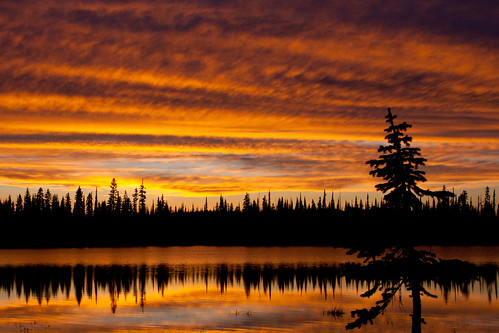
I had left home with the hopes of finding good camas. I got that… and then some! What a wonderful evening drive it was!
I left Lily Lake with my fingers still crossed that I’d be able to continue eastbound — the shorter distance to home — instead of having to turn around and go back the long way. I did hit more snow as well as fallen trees but I was able to skirt around and make it through.
more photos from the evening here: http://www.bigskycountry.net/packermeadows_lilylake
Once again I celebrated Independence Day by spending the day as a spectator guest at the Annual Arlee Celebration powwow in Arlee, Montana, on the Flathead Reservation.
The powwow’s Fourth of July roots go back to the late 1800s, when the reservation’s federal Indian agent told the tribes here that such celebrations were being permanently banned.
It was, the agent explained, time for the Indians to walk away from their traditions and join white society.
So the local Indians told the agent that instead of a powwow, they would throw a party to honor America’s birthday.
“The chief was kind of smart,” Arlee says. “He convinced the agent they were celebrating the Fourth of July.”
In reality, it was the first Arlee Powwow.
A tradition was established with that first Arlee Celebration that is going strong to this day as the 113th Annual Arlee Celebration is held. Over the years, the dances and the regalia have changed as new traditions have been added but the spirit of tradition remains solid. One of these years I need to go on Old Style Day to see the traditional dances of the Salish People. Gaining an understanding of the stick game and other traditional games played at the Celebration is also on my to-do list.
On the Fourth of July, the dance events begin with the Snake Dance.
The Snake Dance was done to begin a War Dance. It was led by a chosen man who gathered the dancers at a designated spot, generally at the camp of the Chief of the celebration. The dancers danced in a single file towards the dance pavilion with the leader weaving and doubling back in in the fashion of a snake. The drummers and singers followed the group singing the Snake Dance song.
~Johnny Arlee, Over a Century of Moving to the Drum (also available online at Amazon & Barnes & Noble if you want a copy and ordering via paper isn’t your thing)

Following the Snake Dance (this year, after a few inter-tribal dances) is the Veterans’ Dance. All Veterans, from all Nations and nationalities, are encouraged to participate in this dance, that they may be honored and thanked for their sacrifices. They are led into the pavilion by the flag bearer. Prayers of thanks are spoken (first in Salish, then in English).


After the Veteran’s Dance, inter-tribal and competition dances are held. Among the competition dances are Traditional, Fancy (Fancy Shawl), Grass, and Jingle. Each dance has it’s own character. Contests are broken up into age brackets. The participating drums (each drum is a group of 5 or more drummers & singers) take turns drumming & singing with the turn passing to the next drum with each song. The drumming and singing penetrate every sense.
Among the entrants in the teen brackets were this beautiful teen Fancy dancer, her beautiful face barely revealing the effort to remain graceful as a butterfly in the second dance as heat and fatigue charge their due, and this handsome Traditional dancer, whose movements and posture tell a story.
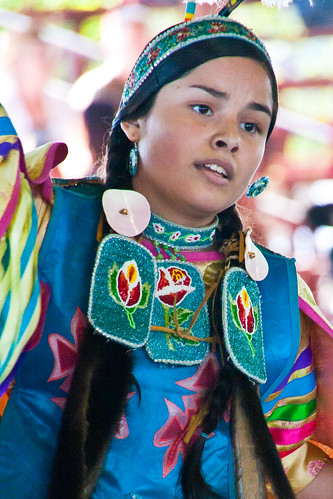
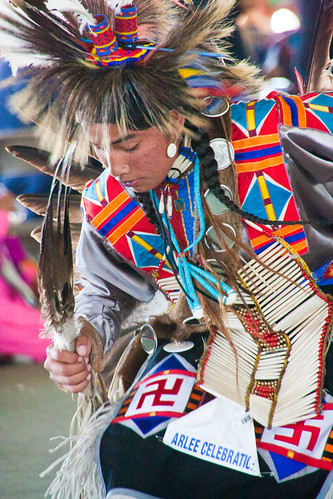
I am always amazed the level of expertise and artistry that is displayed in the ceremonial regalia, from traditional leather, seashells, elk ivory, beads and feathers of traditional regalia to the bright colors, sequins and appliqué designs of more modern regalia such as that worn by Fancy Dancers.
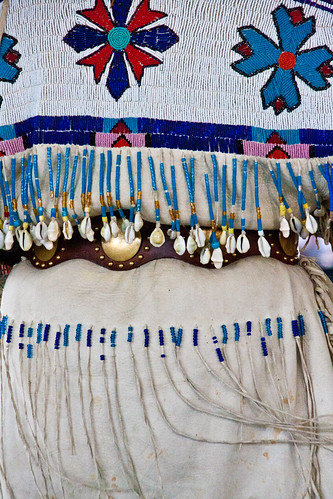
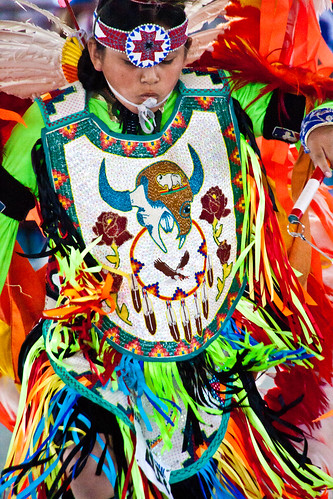
Regarding the Salish language:
The Salish language is currently spoken by less than 50 people, most of whom are over 75 years old. There are no first language fluent Salish speakers under 50.
~Nkwusm Salish Language Institute
If you would like to make a contribution to help support Salish language education, you can visit the website of the Nkwusm Salish Language Institute to make a donation or to purchase merchandise. I’m partial to the Griz Wear (Go Griz!) but other great items are offered as well, including books, bedspreads, bags, etc.
If you’d like to see more of my photos from the 113th Annual Arlee Celebration, you can find them here: http://www.bigskycountry.net/113th_arlee_celebration
Winter came early to Big Sky Country last year. Winter lingered long this year. Spring was wet and gray but not without a few treats. For example, I was surprised to spy a bobcat spying on me at the National Bison Range on June 8.

Spring babies and tender moments are always a treat, too.

Spring bear activity, such as that my sister and I watched on June 14 when a young male was working on making advances on a mama with her second year cub still in tow (though not, we figured, for much longer), makes the days seem brighter.
Yet, those hours of sun were few and far between and it remained cool. The yearning for blue skies, sunshine and warm weather grew stronger by the day.
Then… Summer Solstice. Mother Nature flipped a switch and suddenly, it is summer in Big Sky Country! Snow is still deep in the mountains, but it is melting fast now. The deep slowly melting snow and the wet spring have made for a lavish beginning to summer with deep green and a wealth of wild flowers.
And the treats keep coming. When my mom and I visited the Bison Range last Friday, the theme of the evening was “there’s another one” as we saw four black bears in quick succession one after another. The freshness of spring continues with new life.
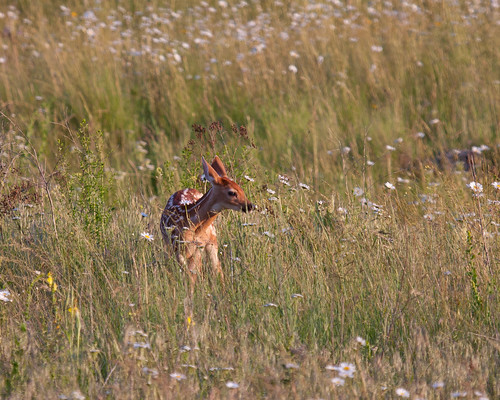
But clearer skies offer additional treats.


A trip out on the Bitterroot trail to check the status of the bitterroot bloom showed that the bitterroots, being several weeks “behind schedule,” are still just tight buds. Maybe this weekend…
Saturday afternoon Mom and I had a few hours to spare so I suggested a trip up to Packer Meadows to check on the camas bloom. We found the first bloomers. On Saturday afternoon there were only a couple dozen camas flowers blossomed out. Soon there will be thousands. It is striking that by the same time last year instead of finding the first bloomers, I was seeking out the last bloomers as most of the camas was shot by this time last year. The snow at Packer Meadows is waist high in places.

We didn’t have time to see if Elk Meadows road is passable from Packer Meadows back down to the Lewis & Clark Highway (aka US Highway 12) that afternoon, so I returned on Sunday afternoon to find out. I found it is not. I swung back around and headed up the road from the opposite end to see if I could make it up to Lily Lake. I made it far enough up the mountain to become optimistic of a glorious sunset at Lily Lake before coming around a curve to discover deep, impassable snow. The snow line is right around the MT/ID border. Right at snow line, and for a couple hundred feet below snow line, there is a fantastic crop of trillium and western meadow rue to be found on wet ground where the snow has only recently melted.


At lower elevations, bear grass is blooming.

I look forward to checking the bitterroot bloom on the Bitterroot Trail at the National Bison Range and the camas bloom at Packer Meadows again this weekend. Given how deep the snow was, I don’t anticipate making it to Lily Lake for sunset for a couple more weeks. I can’t help but wonder what other treats I’ll enjoy between then and now.
Friday night, while having a few cocktails with friends, I decided to load up the car in the morning and head north to Glacier. By the time I got moving (remember those cocktails the night before), loaded the car, stopped for groceries and hit the road it was 11:30. It takes about three hours to get from Lolo to West Glacier. However, as Going to the Sun Road is not open, I drove around the Park to enter at St. Mary. I don’t think I fully appreciated, before, just how long it takes to go around. It was 4:00 or thereabouts when I finally entered the Park at St. Mary. I passed through a number of small storms with breaks of sun in between. Of course, every mile of the drive offered nice views so I enjoyed the drive.
When I arrived at the Rising Sun Campground the wind was blowing 20-30 mph and I was thinking that pitching the tent by myself wasn’t going to be the snap that it usually is. However, I found an ideal campsite against the hill on one side and sheltered by a big boulder on another side — wonderful “cozy” little campsite. That side of the campground was completely out of the wind and my little site was especially so. After making camp I decided to see how far up toward Logan Pass I could go. The answer to that proved to be the Jackson Glacier viewing area. Jackson Glacier is looking very well fed.
There is a wonderful profusion and variety of wildflowers in bloom right now: paintbrush, lupine, larkspur, phacelia, fennel-leaved lomatium, prairie smoke, camas, etc. I found one patch of rock clematis.

St. Mary Lake is always a gem.

After an early dinner back at camp I parked myself in a camp chair overlooking Wild Goose Island on St. Mary Lake. Oh, to have been able to shoot time lapse! I sat for an hour or more watching as the clouds overhead flew by, constantly changing.

While sitting there I heard some movement in the brush to the west of me. Close, but not immediately close… I moved my chair to the other side of the overlook so I could see the brush instead of sitting right against it. After a bit more time I noticed vehicles stopped in the middle of the road 25 yards behind me. I walked back to the road to see what they were looking at, thinking as I walked that it was likely what had been making noise in the brush. It was a mama black bear and her first-year cub who had crossed the road and were heading west. I temporarily abandoned my tripod and chair there at the overlook, changed lenses, and drove west following for a few photos before returning to my gear and cloud watching over Wild Goose Island from the Rising Sun overlook.


I returned to camp early (at least for me) and enjoyed a lively campfire and a couple beers before calling it a night, intending to rise before the sun and return to Rising Sun for the show as the sun lights up the mountains and the lake. A light rain began shortly after I entered the tent and continued off and on throughout the night. When my alarm rang 45 minutes before sunrise, I unzipped my tent flap to check the pre-dawn twilight sky to see low lying clouds and slate gray sky. No point, then, in trying for good sunrise light at Rising Sun so I decided to just go back to sleep.
When I finally rose for the day (around 8:00) I made one run up the road to see if the black bear mama and cub might be in sight before heading out the St. Mary gate and back in the Many Glacier gate. The rain clouds of the morning were breaking up, revealing patches of blue sky over Lake Sherburne to the south, but lingering over the mountains to the north. The meadows along Lake Sherburne are not yet adorned with their summer carpet of wild flowers but the scene was one of beauty regardless. After checking out the Many Glacier area, I headed back for Babb and the highway to head south for the Two Medicine area and Running Eagle Fall. Outside of the Park between Many Glacier and Babb I saw a skittish young cinnamon colored black bear that darted back into the trees when I stopped the car.
Running Eagle Fall is a “trick fall.” During the spring runoff, the water flows over the top of the fall. Later in the summer when streamflow is reduced, the water falls into a chimney hole in the rock ceiling and emerges below. The second photo, for comparison, is from last summer. The plank bridge over the creek is removed for spring runoff and the current dissuaded me from attempting to cross with my camera gear to get closer.


Running Eagle Fall is named for a historic Blackfeet woman warrior who used this site on her vision quests. The area is sacred to Blackfeet people. I share their reverence for the site.
After enjoying Running Eagle Fall, I headed south and west. I debated with myself about reentering the Park at West Glacier as the day was so gray. Yep, you guessed it. Reentering the Park won the argument. I wanted to check out Avalanche Gorge. I’m so glad it did. The gray mist and fog over McDonald Creek did have a certain subdued appeal. The usually vibrant colors of the water, the creek bed and the bordering shale were subdued, to be sure, but the muted tones offered a certain peacefulness.

I enjoyed the walk along the Trail of the Cedars to Avalanche Gorge tremendously. When a visitor walks just a few feet away from the road on the Trail of the Cedars, the visitor is transported to a different world. The visitor is transported to a world of old growth cedar and hemlock, moss and ferns, like one would expect in the rain forests of the Pacific Northwest. Sound is muffled by the dense growth. The sound of the road disappears. Serenity reigns. I always enjoy the Trail of the Cedars but this last weekend I found it especially delightful. A light mist was falling, ferns hanging on the boulders along the boardwalk were bedecked in diamond rain drops, varied thrushes were calling, and Avalanche Creek was roaring.


Avalanche Gorge is a magical spot. Yesterday the water was running high and fast and the sapphire blue color of the water was diluted by the rushing water. When the water is a bit lower and slower the water color is much more dramatic as in this photo from last summer:

After getting my fill of Avalanche Gorge, I lingered along the Trail of the Cedars, loathe to leave behind the serenity.

Reaching the road was almost painful but home beckoned.
More photos from the trip can be viewed here: http://www.bigskycountry.net/glacier_june2011
|
|














































Recent Comments